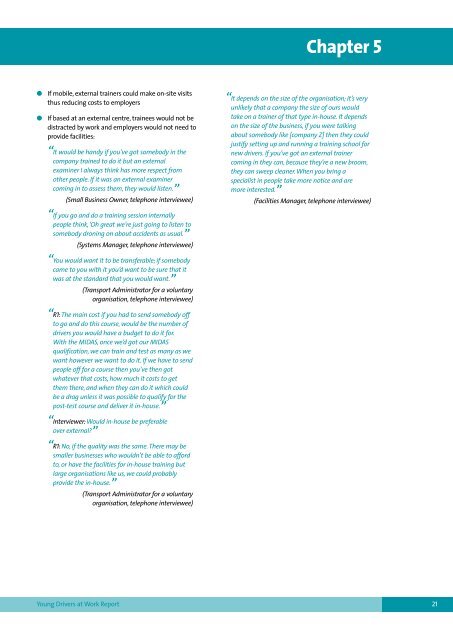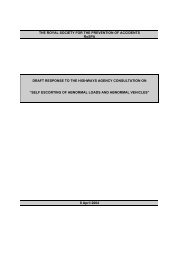RoSPA Young Drivers at Work Report
RoSPA Young Drivers at Work Report
RoSPA Young Drivers at Work Report
Create successful ePaper yourself
Turn your PDF publications into a flip-book with our unique Google optimized e-Paper software.
Chapter 5<br />
●<br />
●<br />
If mobile, external trainers could make on-site visits<br />
thus reducing costs to employers<br />
If based <strong>at</strong> an external centre, trainees would not be<br />
distracted by work and employers would not need to<br />
provide facilities:<br />
“It would be handy if you’ve got somebody in the<br />
company trained to do it but an external<br />
examiner I always think has more respect from<br />
other people. If it was an external examiner<br />
coming in to assess them, they would listen. ”<br />
(Small Business Owner, telephone interviewee)<br />
“It depends on the size of the organis<strong>at</strong>ion; it’s very<br />
unlikely th<strong>at</strong> a company the size of ours would<br />
take on a trainer of th<strong>at</strong> type in-house. It depends<br />
on the size of the business, if you were talking<br />
about somebody like [company Z] then they could<br />
justify setting up and running a training school for<br />
new drivers. If you’ve got an external trainer<br />
coming in they can, because they’re a new broom,<br />
they can sweep cleaner.When you bring a<br />
specialist in people take more notice and are<br />
more interested. ”<br />
(Facilities Manager, telephone interviewee)<br />
“If you go and do a training session internally<br />
people think,‘Oh gre<strong>at</strong> we’re just going to listen to<br />
somebody droning on about accidents as usual. ”<br />
(Systems Manager, telephone interviewee)<br />
“You would want it to be transferable; if somebody<br />
came to you with it you’d want to be sure th<strong>at</strong> it<br />
was <strong>at</strong> the standard th<strong>at</strong> you would want. ”<br />
(Transport Administr<strong>at</strong>or for a voluntary<br />
organis<strong>at</strong>ion, telephone interviewee)<br />
“R1:The main cost if you had to send somebody off<br />
to go and do this course, would be the number of<br />
drivers you would have a budget to do it for.<br />
With the MIDAS, once we’d got our MIDAS<br />
qualific<strong>at</strong>ion, we can train and test as many as we<br />
want however we want to do it. If we have to send<br />
people off for a course then you’ve then got<br />
wh<strong>at</strong>ever th<strong>at</strong> costs, how much it costs to get<br />
them there, and when they can do it which could<br />
be a drag unless it was possible to qualify for the<br />
post-test course and deliver it in-house. ”<br />
“Interviewer:Would in-house be preferable<br />
over external? ”<br />
“R1: No, if the quality was the same. There may be<br />
smaller businesses who wouldn’t be able to afford<br />
to, or have the facilities for in-house training but<br />
large organis<strong>at</strong>ions like us, we could probably<br />
provide the in-house. ”<br />
(Transport Administr<strong>at</strong>or for a voluntary<br />
organis<strong>at</strong>ion, telephone interviewee)<br />
<strong>Young</strong> <strong>Drivers</strong> <strong>at</strong> <strong>Work</strong> <strong>Report</strong><br />
21
















